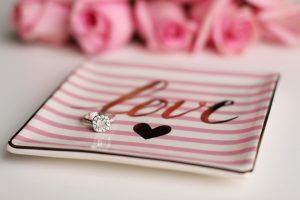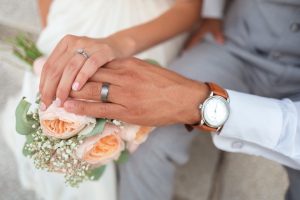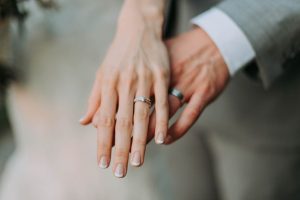Some people wonder whether or not wedding rings and engagement rings are religious. What is the historical religious background of wedding rings? Does wearing a wedding ring indicate that we’re religious?
These days, wedding rings are regarded as having significance for both religious and secular people. We know that wedding rings have a religious history, as they were used by the Romans when they converted to Christianity in the 9th century. However, wedding rings existed long before that as well, having been used by the ancient Egyptians and pagans for thousands of years.
Pre-Religious Use of Wedding Rings
The shape of the ring, having no beginning and no end, is an enduring symbol of everlasting love that has become an important standard in many modern Western weddings.
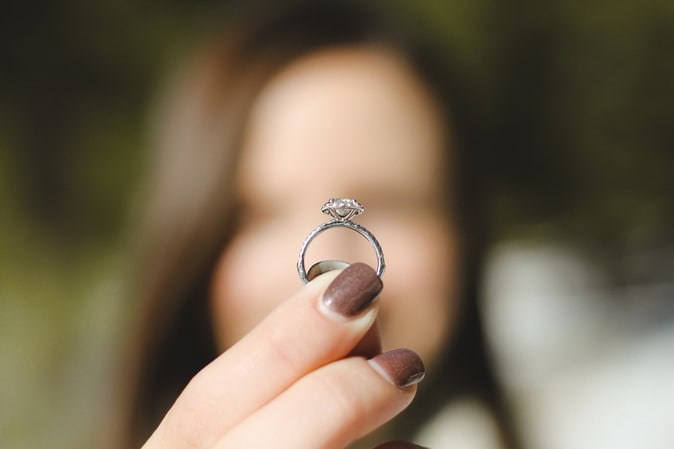
But is this really a modern tradition? Supposedly, wedding rings were used as far back as 3000 to 6000 BC by the ancient Greek and Egyptians. The ancient Egyptians believed the circle represented eternity and endless love. In ancient times, rings were made out of braided reeds or hemp (Source).
By the second century BC, there is recorded evidence of wedding rings being used in the Western world by the Romans.
But instead of being a symbol of pure love or religious connection, wedding rings served a more practical purpose. You probably guessed it — the woman wore a ring as a symbol of belonging to her husband, that she was “taken” (and only the woman wore a ring).
Roman women were given two wedding rings: an iron ring to wear at home while doing chores and a gold ring to wear in public, to “show off” her status.
Weddings at this time were a contract between families rather than a show of love between two people. The ring symbolized the woman being passed from the care of her father to her husband – a property exchange essentially (Source). A bit less romantic, isn’t it?
Use of Wedding Rings in Christianity
There actually isn’t a requirement in the Bible for couples to exchange wedding rings. There are even some passages that suggest flashy jewelry is against the Christian-like values of charity and humility.
However, the exchange of wedding rings has become a common act in most Christian wedding ceremonies these days.
The Western world use of wedding rings came into the picture in a religious way, as we know it, in the 9th century when the Romans converted to Christianity.
Pope Nicholas I proclaimed that engagement rings (betrothal rings) should be worn.
In medieval times, the European style fede ring became popular in Rome, which is a ring featuring two hands or two people clasped together. It is meant to symbolize love and friendship, and a more modern iteration of this is the Irish Claddagh Ring.
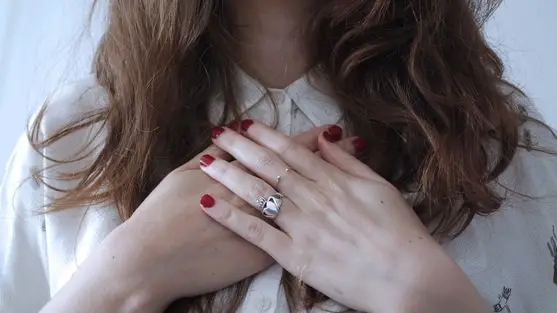
If you’re curious about the so-called “necessity” of buying wedding bands, you might be interested in reading my article Wedding Bands Aren’t Necessary and Here’s Why.
Rings still served to symbolize a contract, as demonstrated by the 1549 edition of the Book of Common Prayer, which said, “With this ring I thee wed… This gold and silver I give thee.” An exchange of goods, or property was implied in the vows.
During the Protestant Reformation in the 16th century, many people did away with engagement rings in protest of the Catholic church.
They instead exchanged wedding rings only. Some Protestants believed that rings were too ostentatious all together, and exchanged thimbles instead.
Early American Puritans continued the practice of not wearing wedding rings, believing them to be too extravagant and against the teachings of the bible.
However, during the Victorian period of the 19th century and into the 20th century, wedding rings and engagement rings were used in religious wedding ceremonies and more and more to symbolize eternal love between two people.
We see this romantic notion reflected in classic diamond marketing campaigns (“A Diamond is Forever”) and in the way men began also wearing wedding rings during World War II.
These days, the exchange of wedding rings is included in the liturgies of most denominations of Christian Church wedding ceremonies (such as the Catholic, Lutheran, and Anglican ceremonies).
Use of Wedding Rings in Non-Christian Religions
Wedding rings are used in Jewish traditions although most Orthodox Jewish men do not wear them (Source).
Wedding rings aren’t part of Muslim wedding traditions but some Muslims do choose to exchange rings. There seems to be a modern debate over whether or not it is permissible within the faith to wear wedding rings.
However, for Muslim weddings in India, there does seem to be an exchange of rings during an engagement ceremony called the Mangni. (Source).
Many cultures around the world choose to exchange some form of either an engagement ring or wedding bands.
Some of them having roots in religion while others have adopted the specific practices of the modern Western tradition (one diamond engagement ring and two metallic wedding bands).
Additionally, some Western Christian religions still do not use wedding rings in their practices, such as large sections of Mennonites and Amish groups.
Secular/Non-Religious Use of Wedding Rings
You don’t have to be religious to exchange and wear engagement or wedding rings. The secular popularity of wedding rings is higher than ever.
Similar in the way that secular weddings will maintain the readings (in the form of poems or speeches) in their ceremonies, many secular couples choose to keep the exchange of rings as part of their big day as well, with the religious elements removed.
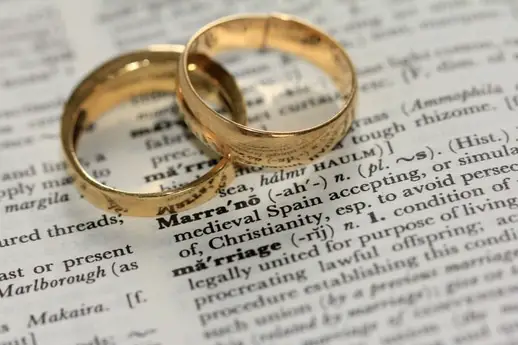
For non-religious couples, or for “spiritual but not religious” couples, the exchange of rings can mean a commitment to one another and an everlasting promise to care for the relationship, without the need for the church’s blessing.
Rings still carry the same meaning that they had for the ancient Egyptians – a symbol of endless love, with no beginning and no end.
Some people choose to wear fede or Claddagh-style rings of the past, or to embrace the more-modern diamond engagement rings. Still, there is no rule as to what one’s engagement ring must look like, or what couple must do in terms of secular ring exchanges.
One popular modern choice is to use birthstones in the engagement or wedding rings, which symbolize a range of hopes for the future of the marriage. For those interested in this tradition, here are the months, birthstones, and what they each symbolize:
| Month | Birthstone | Symbolizes |
| January | garnet | constancy, perseverance |
| February | amethyst | sincerity |
| March | aquamarine, bloodstone | courage |
| April | diamond | innocence |
| May | emerald | success |
| June | pearl, alexandrite moonstone | health |
| July | ruby | passion |
| August | peridot, sardonyx | happiness |
| September | sapphire | clarity |
| October | opal, tourmaline | hope |
| November | topaz | fidelity |
| December | turquoise, zircon | prosperity |
Should We Still Wear Wedding Rings?
In my opinion, it is truly up to the couple whether or not they “should” wear wedding rings for religious or non-religious purposes.
If you’re religious, you’ll most likely want to follow the practices of your church or denomination in terms of what type of rings to exchange and how to exchange them. There are usually pretty clear “rules” or traditions in place and you just need to seek advice from your family or clergy members.
If you’re not religious, it really is completely up to you. Remember that rings don’t have to hold a religious connotation if you don’t want them to. The history is all over the place in terms of what the meaning of wedding rings has been throughout time.
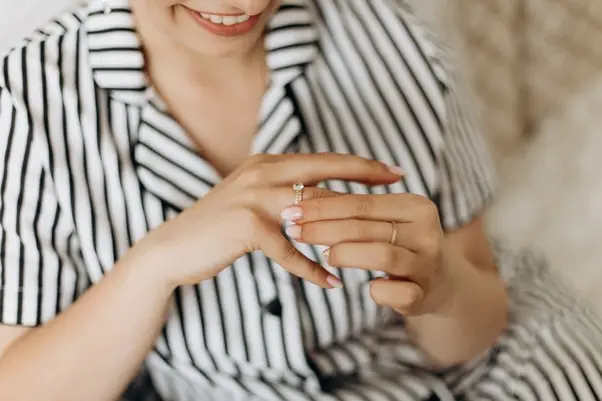
Wedding rings no longer have to symbolize religious connections (unless we want them to), they are not a symbol of “owning” one’s partner anymore, and they can be used to symbolize love and commitment… or skipped all together! The choice is yours 🙂
Just be sure to imbue your ring exchange vows/ceremony with words that will give the kind of significance to the rings that YOU want, if you do decide to go for wedding rings.


